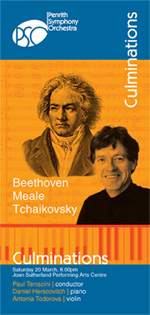
Paul Terracini | conductor
Daniel Herscovitch | piano
Antonia Todorova | violin
The work of Beethoven has often been called the culmination of the Classical era. The grandeur of the virtuoso composer’s final piano concerto is juxtaposed here with the passion of Tchaikovsky’s final symphony, composed in the final months of a complex and turbulent life. Cantilena Pacifica by Australian Richard Meale, who died in 2009, is a fine example of the lyrical style characteristic of much of the composer’s later work.
Beethoven – Piano Concerto No.5 in E-flat major, “Emperor”
Meale – Cantilena Pacifica
Tchaikovsky – Symphony No. 6 in B minor, “Pathétique”
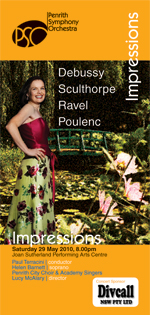
Paul Terracini | conductor
Helen Barnett | soprano
Penrith City Choir & Academy Singers | Lucy McAlary, Director
Ravel’s expression of a nostalgic enthusiasm for Spanish courtly customs and sensibilities, and Debussy’s dreamy response to Mallarmé’s poem about a faun in the heat of the afternoon, are among the quintessential works of the impressionist movement in music. In Earth Cry, Sculthorpe’s instrumental colours evoke feelings of the Australian landscape that seem to go beyond ritual mourning, while Poulenc imbues his sacred text with wide-ranging emotion and drama.
Debussy – Prélude à l’après-midi d’un faune
Sculthorpe – Earth Cry
Ravel – Ma mère l’oye (“Mother Goose” Suite) & Pavane pour une infante défunte
Poulenc – Gloria
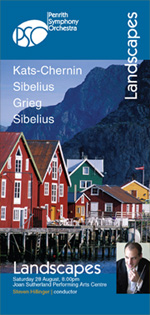
Steven Hillinger | conductor
Few composers paint landscapes in sound as eloquently as the fervent Finnish nationalist Sibelius, whose distinctive orchestration and stirring melodies are nothing short of breathtaking. Also from the Nordic region comes Grieg’s incidental music to Ibsen’s folkloric verse play, Peer Gynt, while Mythic, by Russian-born Australian composer Elena Kats-Chernin, refers to “the mental image [the composer] had of musically entering into a large, mythical cave”.
Kats-Chernin – Mythic
Sibelius – Karelia Suite
Grieg – Peer Gynt Suite No.1
Sibelius – Symphony No. 1 in E minor
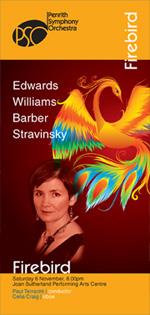
Paul Terracini | conductor
Celia Craig | oboe
Firebird, the ballet which first earned Stravinsky international fame, depicts a glowing bird from Slavic folkloric, both a blessing and bringer of doom to its captor. In White Ghost Dancing, the concept of a white ghost symbolises non-indigenous Australia’s capacity to heal itself through connectedness with the earth. The virtuosity of Vaughan Williams and the poignancy of Barber add further colour to this richly varied musical experience.
Edwards – White Ghost Dancing
Vaughan Williams – Oboe Concerto in A minor
Barber – Adagio for Strings
Stravinsky – Firebird Suite
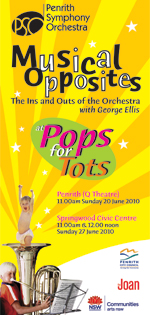
Sunday 20 June 2010, 11.00am
Q Theatre, Penrith
Sunday 27 June 2010, 11.00am and 12.00noon
Springwood Civic Centre, Springwood
George Ellis | conductorA musical entertainment for children 3 to 7 years old, conducted and
presented by George Ellis based on music by Bizet, Mozart, Johann Strauss and more…